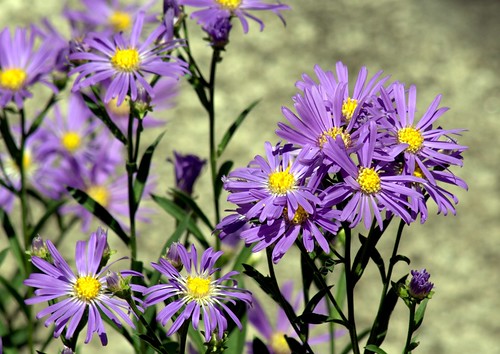20110706 aster by martius
I wrote that Chrysanthemums and perennial asters are in my fall garden. Those seem to be the main flowers when one thinks of fall flowers- those and goldenrod. Because I grew up with wild asters in meadows, I never thought of asters as an interesting plant for a garden. I always preferred chrysanthemums. But nurseries have been coming out with such pretty new asters and they seem so easy to raise and such a delightful addition to the fall garden, that I am having a change of heart about them.
These herbaceous perennials are better known in the UK as Michaelmas Daisies because the peak season of flowering is September and October, with Michaelmas day falling on the 29th September. Gardeners and horticulturists are becoming more and more excited about asters. Hundreds of species and cultivated varieties are grown in gardens throughout the temperate regions of the world because they grow from Hardiness Temperature zones 2 to 9.
Most asters are native to North America, so if you like to grow native plants asters are a must have. Those who enjoy encouraging wildlife to come to your gardens, asters host a number of insects and animals. It is a food source of Monarch butterflies, painted lady butterflies, and the honey bee as well as the goldfinch and others. Some sources say that deer and rabbits don’t eat asters- other sources say they do. I haven’t seen my asters eaten yet. Asters are shelter for the painted lady butterfly, the goldfinch, the northern Bobwhite, the American toad among others. See here. If you would like seed to sow a meadow with asters, check out this.
To see photos of how beautiful asters can look when planted en masse or if you want to see a fabulous aster garden when traveling in England, visit Picton Gardens which is the home of the Plant Heritage National Collection of Autumn Flowering Asters. The garden is only open from August until mid October. But just visiting the website might give you some ideas for a fall garden that you might want to create on your property.
I have more of the dwarf or shorter varieties of asters. See here. Though there are asters that grow 8 or 9 ft.tall. I was saddened to note that a particularly pretty dark purple aster that had been growing in my garden for a few years did not return this year. I do not know the name of this aster because I had bought it at my supermarket which seems to sell more asters among their chrysanthemums.
Not only are asters pretty but they are a late-season source of pollen for bees and other pollinators.They are tough plants, easy to raise and come in various heights for different locations.

